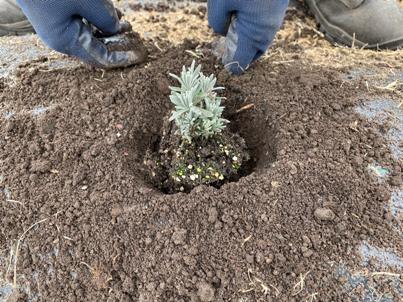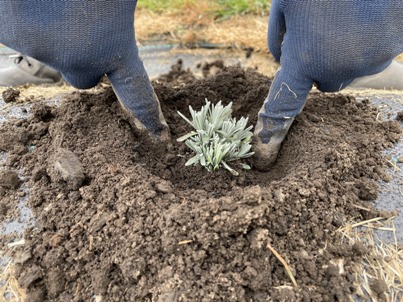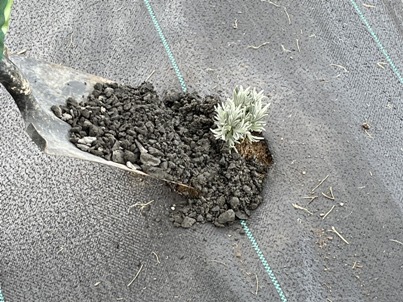Planting Lavender
Good planting practices help ensure first year lavender growth and survival. With attention to lavender’s five basic requirements, the steps for planting lavender should address when/where, soil issues, weed management, spacing/depth, fertilization/pruning, and transplanting. Click on Planting Lavender for a PDF copy of this page.
When/Where
Young lavender (e.g., 4 inch pots) should be planted in the garden during the spring after the last frost and after the soil has warmed to at least 60° F. If late summer or fall, then plant larger more established lavender at least 8 weeks prior to the first frost to ensure winter survival. Choose a location to plant your lavender that has full sun and well-drained soil. Site preparation related to soil issues and weed management needs to be addressed prior to planting.
Soil Issues
Lavender does not tolerate excessive soil moisture, especially during the winter months. Planting on a slope and/or on raised beds will increase drainage. Since lavender grows best in soils with low to moderate fertility you don’t need to amend the soil with organic matter before planting. However, if you have poorly drained clay soils then amend those soils with organic matter such as compost. Soil testing is a quick and accurate method to determine the relative acidity of the soil (pH) and the level of several essential nutrients. Consistently reliable results can only be obtained by submitting samples to a soil-testing laboratory. Test results will recommend adding sulfur to lower the pH to 7.0 if the soil pH is greater than 7.5. If the soil pH is less than 6.5 then garden lime is recommended to raise the pH to around 7.0.
Weed Management
Lavender are poor competitors with weeds in terms of growing space, sunlight, water and nutrients. Weeds negatively effect lavender growth and health, and ultimately the quantity of plant material available for harvest. A weed control strategy should include tilling before planting, followed by subsequent tilling and/or hand weeding. Covering the soil with a water permeable woven weed fabric is another commonly used method for weed control. The weed fabric is secured with 12 inch landscape staples. We only cover our raised beds with weed fabric, and then grow grass between the beds. An organic or rock mulch can be utilized to control weeds alongside of the edge of the weed fabric.
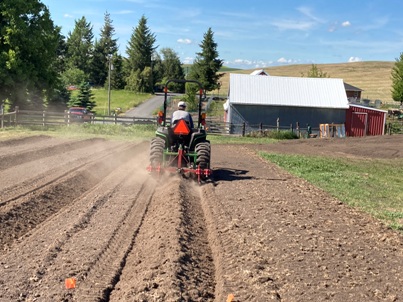
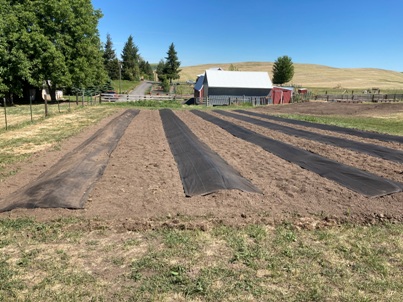
Spacing/Depth
When planting multiple lavender space them 2 to 4 feet apart depending on the cultivar and planting objective. In general, smaller compact English lavenders are spaced 3 feet apart and larger Lavandin lavenders 4 feet apart. Narrower spacings are used for forming a hedge. Well spaced plants promote good air circulation between plants and lessen the opportunity for disease. When lavender is planted in rows, the distance between rows should account for the cultivar’s growth habit and your required access. For example, if grass is grown between rows the distance should be based on the cultivar’s ultimate size and your lawnmower’s width.
If planting lavender through woven weed fabric then burn a hole in the fabric using a template and a hand held butane torch. The hole is burned rather than cut to prevent the woven fabric from fraying. A drill with an auger attachment works well for digging planting holes. The planting hole should be two times deeper and wider than the lavender’s root ball.
Fertilization/Pruning
Prior to planting add 1/4 cup of bone meal to the planting hole and mix thoroughly with the soil. Bone meal, an organic fertilizer, has slow release phosphorus which will promote root development. In addition, prune about 1-2 inches off the branch tips to remove apical dominance and promote additional branch growth, thus creating a more bushy plant. Also, during the first growing season remove flowers to re-direct the plant’s resources to root growth.
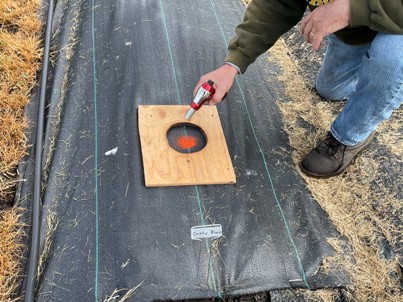
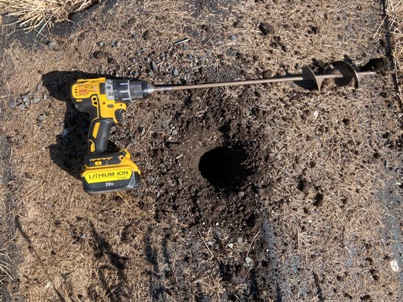

Transplanting
Lavender should be planted no deeper in the ground than it sat in the nursery pot or with the top of the root ball even with the soil line. Soil should be back filled and firmly pressed around the plant, and then watered to compress the soil and remove air pockets. Lastly, we add a 2-3 inch layer of crushed rock (e.g., 5/8 minus gravel) or pea gravel to enhance drainage, insulate the soil during the winter, and provide additional weed control. Avoid using compost or other organic mulch that could retain water which cause root rots or lead to other diseases. Companion plants should have similar sunlight, watering and fertilization requirements.
If you are planting lavender growing in 1 or 2 gallon pots then you will need to burn a hole in the weed fabric the size of the root ball and add 1/2 to 1 cup of bone meal.
